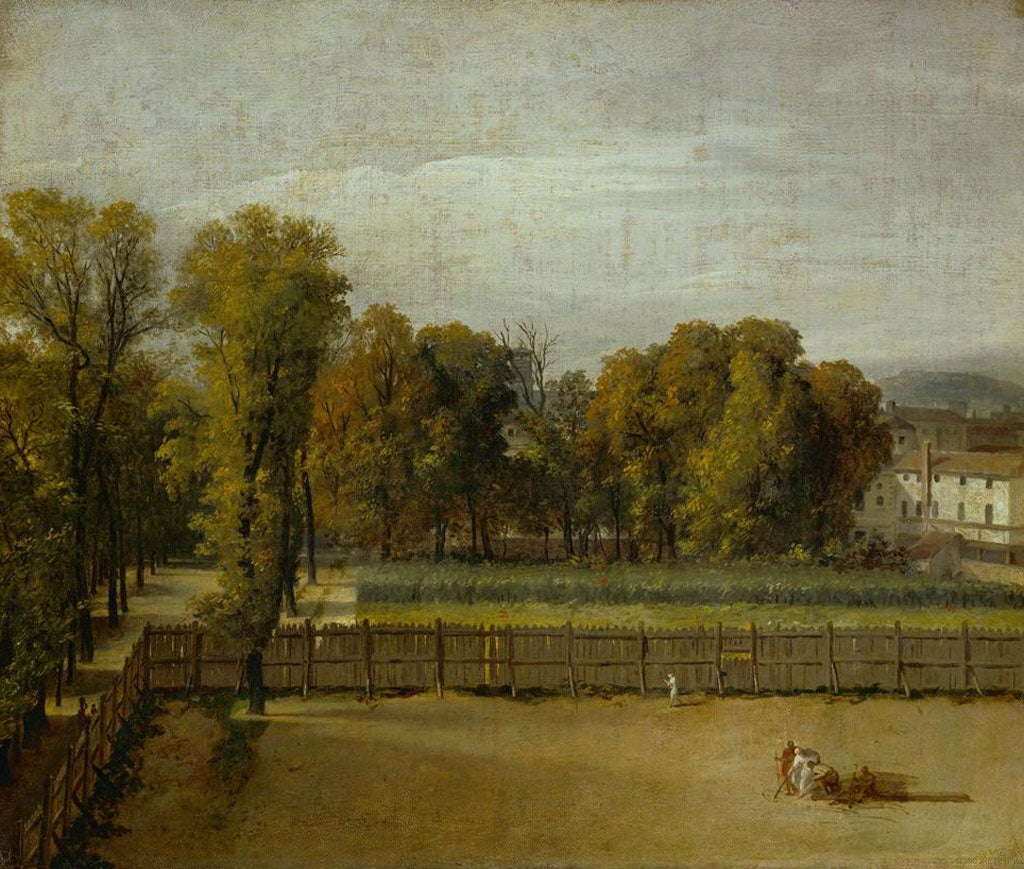Great Works: View of the Gardens of the Palais du Luxembourg, By Jacques-Louis David
Louvre, Paris

Paintings often please, intrigue and, finally, succeed by the depths of their understatement. They inveigle themselves into our sympathies little by little. This is such a painting. The title immediately reminds us that we ought to know much about this subject matter – these are the beautifully regulated gardens about which the centre of the Paris Left Bank seems to pivot, are they not?
What is more, we also think that we know a good deal about its painter, Jacques-Louis David, a great neo-classicising spirit whom we identify almost entirely with the France of the Revolution of 1789 and its glorious/inglorious aftermath. And yet what exactly is David painting here – and, indeed, why is he here at this particularly high vantage point at all, painting this scene that seems to hold in itself so little promise?
David is not generally a painter of this kind. He is a man who deals in symbols, high themes, not a man set apart from the world who is inclined to nose his way into bosky nooks and crannies. In fact, this is the only landscape he is known to have painted. We associate his name with great and often daring re-workings of mythological themes – he painted male nudes as never before – and, perhaps to an even greater extent, with the spirit of the Jacobins – he was a friend of Robespierre's – and, with Napoleon himself, whom he painted repeatedly. In short, David was a man at the forefront of things, a man who raised up and mythologised the actualities of a turbulent France in the throes of mighty and irreversible change.
This is no such picture. No, this painting seems to look forward to a school of painting we more readily identify with the middle of the 19th century – the Barbizon School. It is so low-key, almost idlingly so. The pleasure we take in it hangs in part upon our teasing out reasons to enjoy it. Autumn has come, and with it a slight sense of dust and thirst. The trees are losing their colour, their foliage, gently declining back in the direction of their skeletal winter selves.
The sunlight is thin, weak, unthreatening. About one quarter of the painting – the quarter at the bottom of the canvas – is given over to a wholly undramatic depiction of dusty, dun-coloured ground, quite fenced off from the rest. A very small and insignificant group of human beings is clustered there, rather as Millet might later have painted such a group. Millet's labourers would have been purposeful in ways we could immediately understand and admire. They would have been large enough to give us a vivid impression of the essential nobility of toil. Not so here. Are these people raking the earth itself? Are they mark-making? Are they engaged in an inscrutable game of some kind?
What we do know for certain is that after the Revolution, parts of the Luxembourg Gardens were handed over to be tilled by the common people – in the new spirit of egalitarianism, no doubt. There is not much to be tilled here though, not at this time of year, not much evidence at all of Keats's season of mellow fruitfulness. Mellow fruitlessness?
Two factors seem to be at odds with each other in this painting: order and disorder. That fence looks makeshift in the extreme – shockingly makeshift for such an august location. And yet the layout of the gardens themselves, that perfect alignment of trees, for example, somewhat reminds us of how the Luxembourg Gardens are these days, a project that depends for its grandeur and its power to impress upon the taming and ordering of nature in the interests of human reason. And so it is here. But the tops of the trees tell quite a rather story. In these gardens, we are used to the sight of severely pollarded trees. Nature is to be tamed and regulated. Here things have got out of hand. The unruly crowns of the trees are rejoicing in their untamed spirit.
And how did he come to paint from such a high vantage point? Because he was in prison. This is likely to have been the view that he saw from his cell. Meditating upon partially untamed nature in this way may have helped his spirit to breathe.
About the artist: Jacques-Louis David (1748-1825)
Jacques-Louis David was born in Paris, and is closely associated with the Revolution of 1789. After the declaration of a Republic in 1792, he was elected Deputy from Paris to the National Convention, and was among those deputies who condemned Louis XVI to death for treason. A friend of Robespierre's, he was imprisoned in 1794 for his role in the Terror. In 1804, he was appointed first Painter to Napoleon, the new Emperor of the French.
Subscribe to Independent Premium to bookmark this article
Want to bookmark your favourite articles and stories to read or reference later? Start your Independent Premium subscription today.

Join our commenting forum
Join thought-provoking conversations, follow other Independent readers and see their replies